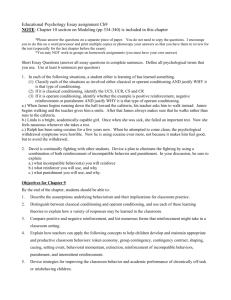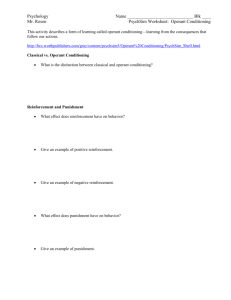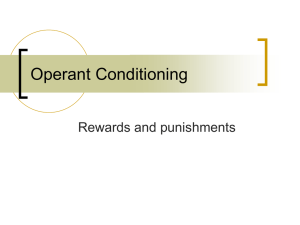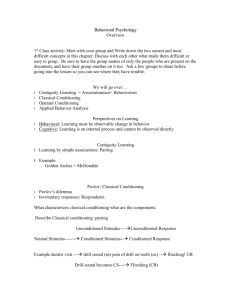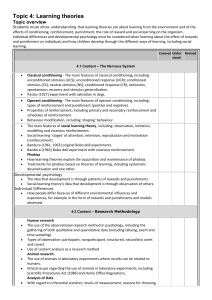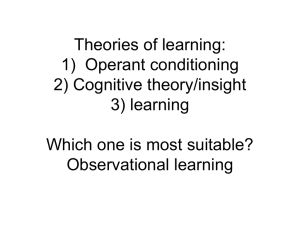Document
advertisement
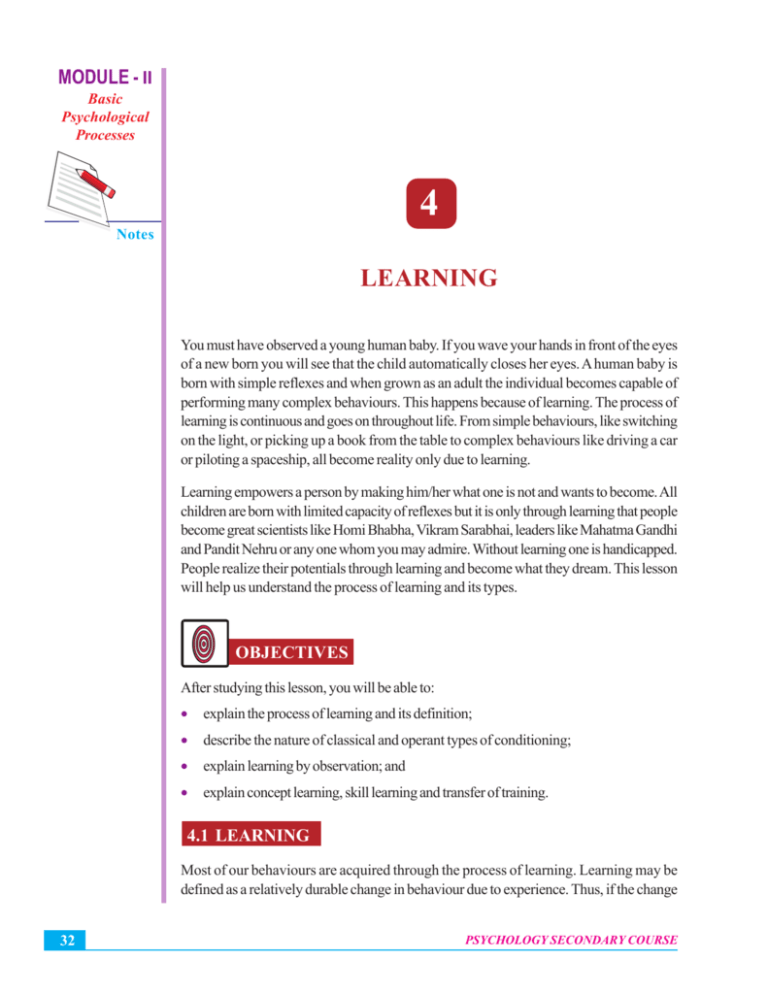
MODULE - II Learning Psychology Secondary Course Basic Psychological Processes 4 Notes LEARNING You must have observed a young human baby. If you wave your hands in front of the eyes of a new born you will see that the child automatically closes her eyes. A human baby is born with simple reflexes and when grown as an adult the individual becomes capable of performing many complex behaviours. This happens because of learning. The process of learning is continuous and goes on throughout life. From simple behaviours, like switching on the light, or picking up a book from the table to complex behaviours like driving a car or piloting a spaceship, all become reality only due to learning. Learning empowers a person by making him/her what one is not and wants to become. All children are born with limited capacity of reflexes but it is only through learning that people become great scientists like Homi Bhabha, Vikram Sarabhai, leaders like Mahatma Gandhi and Pandit Nehru or any one whom you may admire. Without learning one is handicapped. People realize their potentials through learning and become what they dream. This lesson will help us understand the process of learning and its types. OBJECTIVES After studying this lesson, you will be able to: • explain the process of learning and its definition; • describe the nature of classical and operant types of conditioning; • explain learning by observation; and • explain concept learning, skill learning and transfer of training. 4.1 LEARNING Most of our behaviours are acquired through the process of learning. Learning may be defined as a relatively durable change in behaviour due to experience. Thus, if the change 32 PSYCHOLOGY SECONDARY COURSE Learning in behaviour is temporary, or due to instinct or maturation, it is not learning. The key feature of learning is experience. Any change in behavior in the absence of practice or experience does not qualify as learning. For example the maturational changes in the child, like crawling, standing and walking at certain ages are not included in learning. Similarly, illness and drug induced temporary changes are not due to learning. To qualify as learning, a change in behaviour must be relatively enduring. MODULE - II Basic Psychological Processes Notes Interestingly enough learning is not directly observable. It is often inferred from changes in the external behaviour. It is apparent in terms of improvement in the performance. You may recollect your own early childhood experiences when you were required to learn alphabets. In the beginning we make more errors. However, when we start practicing the errors decrease and a time comes when the behaviour becomes flawless. The decrement in the number of errors with increase in practice clearly indicates that learning is taking place. How Do We Learn? Learning helps us adapt to the surrounding environment. After living in a particular sociocultural environment for some time, we learn the norms of the society and all that is expected of us and become responsible citizen and members of family and work organization. All this is possible on account of learning. We use learning to acquire various types of skills. But the crucial question is how do we learn? Psychologists, on the basis of studies on human beings and on animals, have tried to explain the process of learning. They have identified some procedures that are used in the acquisition of simple as well as complex responses. The two basic types of learning are classical conditioning and operant or instrumental conditioning. In addition, we have observational learning, verbal learning, concept learning, and skill learning. Let us briefly consider some of the important types of learning. (i) Classical Conditioning : Learning through Association Classical conditioning is also known as Pavolovian conditioning because it was discovered by a Russian scientist Ivan P. Pavlov who was interested in studying stimulus-response relationship. He worked with dogs. The animal was harnessed and food was presented to the dog by a laboratory assistant. Pavlov realized that the salivary response had been learned by the dog. He proceeded to study this type of learning in detail. (See Fig. 4.1) Pavlov presented to the dog a series of trials in which a tone (buzzer) was paired with food (biologically important stimulus). The learning trials consisted of pairing the tone, (Conditioned Stimulus or CS) with food (Unconditioned Stimulus or UCS). The tone presented was rather short (e.g., 10 secs) and the time interval between the tone and presentation of food, was between 2 to 3 minutes. PSYCHOLOGY SECONDARY COURSE 33 MODULE - II Learning Psychology Secondary Course Basic Psychological Processes Notes Fig. 4.1: Classical Conditioning During the initial trials the dog salivated when the food was presented. Secretion of saliva to food is a natural response and, therefore, the saliva is called Unconditioned Response (UR). Later, the buzzer was presented first. It was followed by food. After some pairing trials of buzzer and food, the dog started salivation at the ringing of buzzer alone. The buzzer is called Conditioned Stimulus (CS) because the dog has been conditioned to salivate at the presentation of the buzzer itself. The secretion of saliva on the presentation of buzzer is called Conditioned Response (CR). The steps of conditioning process are shown in Fig. 4.2. Procedure Response Before conditioning Food Salivation (UCS) (UCR) Buzzer Orienting Response (CS) During conditioning (Acquisition phase) Food + Buzzer Salivation (UCS) (CS) (CR) (Repeated pairing of the UCS and CS ) After conditioning Buzzer Salivation (CS) (CR) UCS = Unconditioned Stimulus; CS = Conditioned Stimulus; UCR = Unconditioned Response; CR = Conditioned Response Figure 4.2: The process of classical conditioning. 34 PSYCHOLOGY SECONDARY COURSE Learning It can be observed from Fig. 4.2 that originally the sound of the buzzer (CS) elicits only an orienting response (alerting response) and elicits salivation when the food is consistently presented in close association with the buzzes. Immediately after the buzzer is rung, the animal elicits salvation. This is called acquisition. It has been found that if the buzzer (CS) is presented on each trial but the food (US) is not presented, extinction will take place. That is, the buzzer will no more elicit saliva (CR) and if it is continued for some time extinction will take place. MODULE - II Basic Psychological Processes Notes It has also been found that if a gap of some duration occurs after extinction and if the buzzer (CS) is again presented without food (US) the dog will salivate (produce CR) for a few trials. This recovery of CR after extinction is called spontaneous recovery. (ii) Operant Conditioning : Modification of Behaviour through Reinforcement If a child completes the home work she is praised (rewarded) by the parents and the child learns to perform the task. If the child breaks a plate, he/she is scolded (punished) and she will learn not to repeat the behaviour. This is called Operant Conditioning or instrumental conditioning. In other words, we learn to perform behaviours that produce positive outcomes and avoid behaviours that yield negative outcomes. We may define operant conditioning as a process through which organisms learn to repeat behaviours that produce positive outcomes or avoid or escape from the negative outcomes. B.F. Skinner is considered as the most influential psychologist advocating the role of operant conditioning in learning. He developed an experimental chamber (called Skinner Box) to study learning process in rats. (see Fig. 4.3) The chamber included a lever attached to the front wall. Pressing the lever is the response to be learned. The hungry rat is placed in the chamber and it starts doing random activity in it. After some time, the rat accidentally presses the lever and a pellet of food drops automatically in the plate and the rat eats it. After eating the pallet the rat again starts activity in the chamber. After some activity it again presses the lever and gets pellet (a reward). Gradually the random activity changes to more specific activity around the lever. Finally, the rat learns that pressing the lever results in dropping of the food, a satisfying outcome. In other words the pressing of lever by the rat is instrumental in providing food (reinforcement). The response (pressing the lever) is reinforced and the behaviour is acquired or learned. The pressing of lever by the rat is instrumental in getting the food, a satisfying consequence (positive reinforcement) and that is why this type of learning is also called Fig. 4.3: Skinner Box PSYCHOLOGY SECONDARY COURSE 35 MODULE - II Basic Psychological Processes Learning Psychology Secondary Course instrumental learning. It is also called operant conditioning because the behaviour of rat or any organism is a kind of operation on the environment. INTEXT QUESTION 4.1 Notes Fill in the blanks with appropriate words. 1. Learning is a ………….. permanent change in ………….. 2. Pavlovian conditioning is known as ……………… conditioning. 3. ……………. advocated the role of operant conditioning. 4. Operant conditioning is also called …………. learning. 4.2 REINFORCEMENT AND OBSERVATIONAL LEARNING Much of the human learning could be explained with the help of operant conditioning method. For example, parents and other authorities attempt to discourage aggressive behaviours by punishing them and reward for good behaviours. The role of reinforcement is very crucial in operant conditioning. It can be positive or negative. Let us understand these two types of reinforcement. Positive Reinforcement : Reinforcement is any operation or action that increases the rate of response. In Skinner’s experiment the rat responded by pressing the lever and obtained food. This is called positive reinforcement. So, a positive reinforcement or reward (e.g., food, sexual pleasure, etc.) is the operation that increases the strength of a specific behaviour. Positive reinforcement is any stimulus that strengthens a response that precedes it (e.g., lever pressing is reinforced by food). Negative Reinforcement : Another quite different way of increasing the rate of response is through negative reinforcement. Suppose that in the Skinner Box the rat receives electric shock to the feet every second. When the rat presses the lever, the shock is removed for 10 secs. This increases the rate of response. This procedure is called negative reinforcement which involves application of an aversive stimulus (e.g. heat, electric shock, scudding etc.). The word “negative” refers to the nature of the reinforcer (aversive stimulus). It is a “reinforcement” because it increases the rate of response. This procedure is called “escape” learning because the rat can escape the shock if it presses the lever. Another kind of negative reinforcement can result in conditioning called “avoidance” learning where the rat can avoid the shock by pressing the lever. In escape or avoidance learning the reinforcer is negative and the organism learns to escape or avoid its presence. 36 PSYCHOLOGY SECONDARY COURSE Learning Schedules of Reinforcement How do we reinforce the correct responses? It could be by using continuous or partial reinforcement. In the case of continuous reinforcement, every correct response is reinforced. For example, when the rat presses the lever every time it gets a food pellet (reinforcement). Alternatively, the responses are reinforced partially or intermittently (some times only). The continuous reinforcement is useful for establishing or strengthening new behaviours. The partial reinforcement, on the other hand, is more powerful in maintaining the acquired behaviours. MODULE - II Basic Psychological Processes Notes Observational Learning : Modelling Observational learning is the third major way we learn. Acquiring new skills by observing the behaviour of others is very common. It is a part of everyday life. Observational learning depends on the existence of appropriate model in one’s environment. That is, the child picks up behaviour while the appropriate model is performing an activity. For example, young people learn aggression through watching the actions of others (models). Television programmes and movies provide much of the learning to the young people. When children watch violence on TV they tend to learn such behaviours. We learn various social roles through observational learning. However, observational learning is a complex process, far more complex than mere imitation. Children acquire information and learn skills through observational learning but do not put it into immediate use. People, particularly youngesters, can often be influenced in positive ways when they have appropriate role models. INTEXT QUESTION 4.2 State whether the following statements are True or False: 1. Positive reinforcement is any action that reduces the rate of response. 2. The aversive response is called as escape learning. 3. Reinforcement can be partial or continuous. 4. Partial reinforcement does not help in maintaining behaviour. 5. Observational learning depends on the existence of appropriate model. 4.3 SOME OTHER TYPES OF LEARNING Till now we have read about learning and conditioning. Now we will read briefly about the other types of learning. PSYCHOLOGY SECONDARY COURSE 37 MODULE - II Basic Psychological Processes Notes Learning Psychology Secondary Course Verbal Learning You are reading this lesson and trying to understand the concept of learning. This is possible because of verbal learning. You have learned language. People in different parts of the world learn different languages. The process of learning language is called verbal learning. If you recollect your younger days you will notice that you started with identifying alphabets, then moved to words and finally sentences. When you learn a foreign language you use pairs of words. Psychologists study how various procedures like serial learning and paired associates learning are used. Concept Learning This is about developing categories of objects and events. It is very important in our life that we should discriminate between things on the basis of some criterion. For example, the terms ‘boys’, ‘girls’, ‘fruits’ and ‘furniture’ refer to concepts. A concept involves a variety of objects clubbed together. Use of categories or class names helps us to communicate and perform different activities. The concepts may be natural or artificial. They may be as abstract and concrete. Love, freedom and democracy are examples of abstract concepts. Cow, table, boy, girl, orange and rose are examples of concrete concepts. While learning a concept we make one response to all the stimuli belonging to that category. Thus we refer to all kinds of tables as table or all boys as boy. In fact all kinds of higher learning necessarily involves concept learning. Concepts help us to reduce the complexity of our world. In lesson 7 you will read more about concept formation. Skill Learning An important area of learning involves acquiring various types of skills like riding a bicycle, writing, car driving, piloting an air craft, leading a group and motivating others etc. All of these involve skills. Those who are able to learn these and other skills get opportunities in life. Once the skill is acquired one may over learn it. It may become automatic and one is able to perform it with ease and comfort. As a result people perform tasks spontaneously and can perform more than one task at a time (e.g. talking to a person and car driving). 4.4 TRANSFER OF TRAINING It is interesting to note that learning of one task does not remain confined to that specific task only. That learning is used in other situations also. A person’s ability to utilize knowledge, skills and any kind of learning is highly appreciated. If a child learns to multiply or divide she can use the process not only in the class but also in the market place or at home if it is required. Transfer of training refers to the process of using earlier learning in a new situation. It is positive if the first learning helps the second learning. It can be negative if the first learning interferes with the second learning. It can be zero if the first learning neither helps nor interferes with the second learning. 38 PSYCHOLOGY SECONDARY COURSE Learning Learning transforms a person in many ways and occurs throughout one’s life. Good learners utilize each and every opportunity as an occasion for learning. The methods or types of learning mentioned earlier provide only some basic ideas about learning. The changes that take place in personality, attitude and interest are also consequences of certain types of learning. They take place in complex ways. As learning progresses your ability to learn also develops. If you learn you become a better person, flexible in approach and competent enough to appreciate the reality. MODULE - II Basic Psychological Processes Notes Some Tips for Better Study Habits Studying of a topic can be facilitated if you realize that effort and motivation both are important. In order to gain more while preparing a topic or studying some thing you need to attend to the following points. Study at a Specific Place: You must study in a quiet, well-lighted area free of disturbance. If possible, you should also have at least one place where you only study. Do nothing else at the spot: Keep magazines, radios, friends, and other distractions out of that area. In this way, studying will become strongly linked with one specific place. Once there, you’ll find it relatively easy to get started. Organize Your Study through Spaced Sessions: It is quite reasonable to review intensely before an exam. However, if you are actually learning some topic for the first time you are asking for trouble. It has been found that spaced practice is a more efficient way to study. It involves a large number of relatively short study sessions, rather than one or two long ones (called massed practice). Use Memory Aids: Psychologists have found many techniques useful for improving memory. Most of them link new information to certain ideas or images that are easy to remember. Try to Test Yourself: When studying you can arrange to take several practice tests before the real one in examination. In other words, studying should indicate self-testing by use of flash cards, learning checks, a study guide or questions you ask yourself. Over Learning: It has been found that many students underprepare for exams, and most overestimate how well they will do in exams. A solution to both problems is overlearning. To overlearn, you should continue studying beyond bare mastery of a topic. This means that you need to give yourself time for extra study and review after you think you are prepared for a test. Avoid procrastination: A tendency to procrastinate is almost universal. Procrastinators put off work until the last moment. They work only under pressure, skip classes and give false reasons for late work. This has negative effect on learning and performance. Use of a formal time schedule and setting up specific goals may help to study more effectively. PSYCHOLOGY SECONDARY COURSE 39 MODULE - II Learning Psychology Secondary Course Basic Psychological Processes INTEXT QUESTIONS 4.3 1. What are the main types of learning? _______________________________________________________________ Notes 2. What is transfer of training? _______________________________________________________________ WHAT YOU HAVE LEARNT 40 • Learning may be defined as a relatively durable change in behaviour due to experience. If the change in behaviour is temporary, or due to instinct or maturation, it is not learning. • Learning helps us adapt to our environment. • The two basic types of learning are classical conditioning and operant conditioning or instrumental learning. • Classical conditioning involves pairing of a neutral stimulus and a natural stimulus (CS and UCS) leading to formation of association between neutral stimulus and response. • Operant conditioning is a process through which organisms learn to repeat behaviours that produce positive outcomes or avoid or escape from the negative outcomes. • Skinner defined reinforcement as any operation or action that increases the rate of response. • In escape or avoidance learning the reinforcer is negative and the organism learns to escape or avoid its presence. • In the case of continuous reinforcement, every correct response is reinforced. • The process of learning language is called verbal learning. • An important area of learning involves acquiring skills like riding a bicycle, writing, car driving, piloting an air craft, leading a group, motivating others etc. • Observational learning is also used in acquiring new skills by observing the behaviour of others. • Transfer of training refers to the process of using earlier learning in a new situation. It is positive if the first learning helps the second learning. • Learning transforms a person in many ways and occurs throughout one’s life. Good learners utilize each and every opportunity as an occasion for learning. PSYCHOLOGY SECONDARY COURSE Learning MODULE - II Basic Psychological Processes TERMINAL QUESTIONS 1. What is learning? Give an example? 2. Describe the process of classical conditioning. 3. What are the main types of reinforcement? What is the role of reinforcement in operant conditioning? Notes 4. Give examples of observational learning and skill learning. 5. What is the significance of transfer of training? ANSWERS TO INTEXT QUESTIONS 4.1 1. relatively, behaviour 2. classical 3. B.F. Skinner 4. Instrumental 4.2 1. False 2. True 3. True 4. False 5. True 4.3 1. Skill learning, verbal learning and concept learning. 2. Transfer of training refers to the process of using earlier learning in a new situation. Hints for Terminal Questions 1. Refer to section 4.1 2. Refer to section 4.1 3. Refer to section 4.2 4. Refer to section 4.3 5. Refer to section 4.4 PSYCHOLOGY SECONDARY COURSE 41


